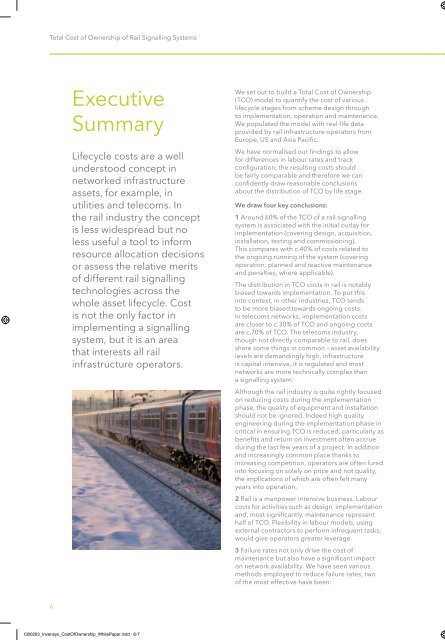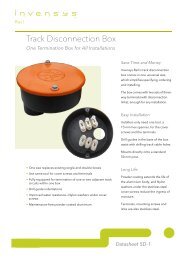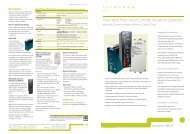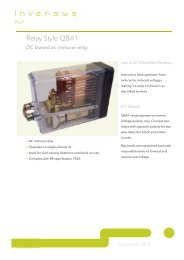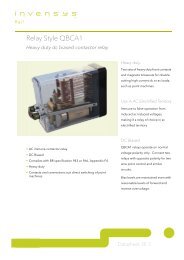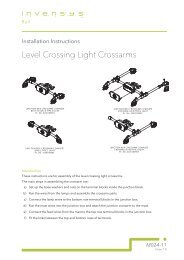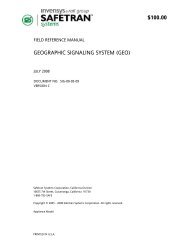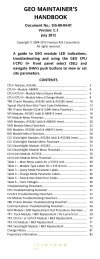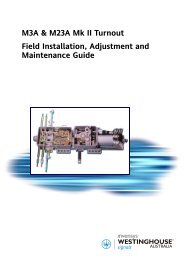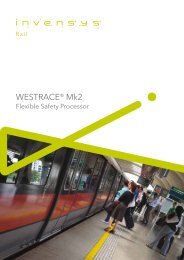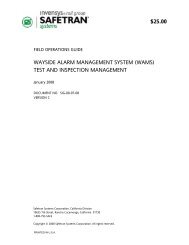Total Cost of Ownership of Rail Signalling Systems ... - Invensys Rail
Total Cost of Ownership of Rail Signalling Systems ... - Invensys Rail
Total Cost of Ownership of Rail Signalling Systems ... - Invensys Rail
Create successful ePaper yourself
Turn your PDF publications into a flip-book with our unique Google optimized e-Paper software.
<strong>Total</strong> <strong>Cost</strong> <strong>of</strong> <strong>Ownership</strong> <strong>of</strong> <strong>Rail</strong> <strong>Signalling</strong> <strong>Systems</strong> <strong>Total</strong> <strong>Cost</strong> <strong>of</strong> <strong>Ownership</strong> <strong>of</strong> <strong>Rail</strong> <strong>Signalling</strong> <strong>Systems</strong><br />
6<br />
Executive<br />
Summary<br />
Lifecycle costs are a well<br />
understood concept in<br />
networked infrastructure<br />
assets, for example, in<br />
utilities and telecoms. In<br />
the rail industry the concept<br />
is less widespread but no<br />
less useful a tool to inform<br />
resource allocation decisions<br />
or assess the relative merits<br />
<strong>of</strong> different rail signalling<br />
technologies across the<br />
whole asset lifecycle. <strong>Cost</strong><br />
is not the only factor in<br />
implementing a signalling<br />
system, but it is an area<br />
that interests all rail<br />
infrastructure operators.<br />
We set out to build a <strong>Total</strong> <strong>Cost</strong> <strong>of</strong> <strong>Ownership</strong><br />
(TCO) model to quantify the cost <strong>of</strong> various<br />
lifecycle stages from scheme design through<br />
to implementation, operation and maintenance.<br />
We populated the model with real-life data<br />
provided by rail infrastructure operators from<br />
Europe, US and Asia Pacifi c.<br />
We have normalised our fi ndings to allow<br />
for differences in labour rates and track<br />
confi guration; the resulting costs should<br />
be fairly comparable and therefore we can<br />
confi dently draw reasonable conclusions<br />
about the distribution <strong>of</strong> TCO by life stage.<br />
We draw four key conclusions:<br />
1 Around 60% <strong>of</strong> the TCO <strong>of</strong> a rail signalling<br />
system is associated with the initial outlay for<br />
implementation (covering design, acquisition,<br />
installation, testing and commissioning).<br />
This compares with c.40% <strong>of</strong> costs related to<br />
the ongoing running <strong>of</strong> the system (covering<br />
operation, planned and reactive maintenance<br />
and penalties, where applicable).<br />
The distribution in TCO costs in rail is notably<br />
biased towards implementation. To put this<br />
into context, in other industries, TCO tends<br />
to be more biased towards ongoing costs.<br />
In telecoms networks, implementation costs<br />
are closer to c.30% <strong>of</strong> TCO and ongoing costs<br />
are c.70% <strong>of</strong> TCO. The telecoms industry,<br />
though not directly comparable to rail, does<br />
share some things in common – asset availability<br />
levels are demandingly high, infrastructure<br />
is capital intensive, it is regulated and most<br />
networks are more technically complex than<br />
a signalling system.<br />
Although the rail industry is quite rightly focused<br />
on reducing costs during the implementation<br />
phase, the quality <strong>of</strong> equipment and installation<br />
should not be ignored. Indeed high quality<br />
engineering during the implementation phase in<br />
critical in ensuring TCO is reduced, particularly as<br />
benefi ts and return on investment <strong>of</strong>ten accrue<br />
during the last few years <strong>of</strong> a project. In addition<br />
and increasingly common place thanks to<br />
increasing competition, operators are <strong>of</strong>ten lured<br />
into focusing on solely on price and not quality,<br />
the implications <strong>of</strong> which are <strong>of</strong>ten felt many<br />
years into operation.<br />
2 <strong>Rail</strong> is a manpower intensive business. Labour<br />
costs for activities such as design, implementation<br />
and, most signifi cantly, maintenance represent<br />
half <strong>of</strong> TCO. Flexibility in labour models, using<br />
external contractors to perform infrequent tasks,<br />
would give operators greater leverage.<br />
3 Failure rates not only drive the cost <strong>of</strong><br />
maintenance but also have a signifi cant impact<br />
on network availability. We have seen various<br />
methods employed to reduce failure rates, two<br />
<strong>of</strong> the most effective have been:<br />
i. Monitor and publish performance information<br />
at the team level. Field engineers need to feel<br />
their efforts have consequences both good<br />
(appealing to pride) and bad (appealing to<br />
competitiveness). This has resulted in a 44%<br />
reduction in failures at one operator. A further<br />
enhancement to this is to set targets and reward<br />
performance, again at the team level – this tends<br />
to stimulate innovation (in working practice) and<br />
faster or more effective problem resolution.<br />
ii. Condition-based asset monitoring. Being<br />
able to monitor a component to get early<br />
warning <strong>of</strong> imminent failure allows maintenance<br />
resource to be directed more economically and<br />
failures to be avoided.<br />
4 Reducing TCO is the end goal once the<br />
distribution <strong>of</strong> costs across life stages and<br />
cost drivers are understood. We note several<br />
ideas – some big (entailing capital investment),<br />
some small (minimal cost) that both operator<br />
and equipment vendors can drive:<br />
i. Modular equipment. Off-site assembly and<br />
testing <strong>of</strong> discrete standardised signalling<br />
modules enables a more effi cient and robust<br />
approach to system testing. It also requires less<br />
time onsite thereby reducing disruption to the<br />
network and allows testing to be completed with<br />
fewer possessions (which is expensive as most<br />
<strong>of</strong> our operators were capacity constrained).<br />
ii. Handheld technology to de-skill/improve<br />
quality <strong>of</strong> installation. Use <strong>of</strong> mobile handheld<br />
technology to run testing and commissioning<br />
scripts/routines allows elements <strong>of</strong> the testing<br />
process to be de-skilled which in turn reduces<br />
reliance on scarce engineering resource and<br />
allows a more methodical and robust approach<br />
to installation. The latter point was particularly<br />
stressed by an operator who conceded that the<br />
quality <strong>of</strong> installation was one <strong>of</strong> the biggest<br />
sources <strong>of</strong> subsequent equipment failure.<br />
iii. In situ component reliability shared with<br />
equipment vendor. There was a surprising lack<br />
<strong>of</strong> information sharing between operator and<br />
equipment vendor, at best this was done in an<br />
ad hoc fashion. Where the feedback loop was<br />
well-established, unsurprisingly there was better<br />
product performance. This was particularly<br />
important as a high proportion <strong>of</strong> failures tended<br />
to be traced to a small number <strong>of</strong> components<br />
that repeated failed.<br />
iv. Condition-Based Maintenance (CBM).<br />
Early detection <strong>of</strong> potential component failure<br />
(components reporting issues themselves) allows<br />
maintenance resource to be prioritised by need<br />
rather than routine and failures to be avoided.<br />
There’s a less capital intensive approach to CBM<br />
that compares usage data against statistical data<br />
to predict failures, this may appeal to operators who<br />
have large networks that make the retro-fi tting <strong>of</strong><br />
sensors an unwieldy and expensive task.<br />
v. Planned maintenance regimes that take into<br />
account the proximity <strong>of</strong> assets allow multiple<br />
components to be inspected during the same visit<br />
– this reduces travel time which can be equivalent<br />
to the time spent on an inspection. A further step<br />
to increase effi ciency and consistency would be<br />
to link maintenance regimes to components in the<br />
asset register which could in turn drive a workload<br />
management system. Engineers could then<br />
have their scheduled tasks downloaded to their<br />
handheld device and update the asset history<br />
on completion <strong>of</strong> the inspection.<br />
vi. Handheld technology as a training tool.<br />
The diversity <strong>of</strong> signalling equipment that needs<br />
to be maintained by an engineer presents a<br />
training challenge. Handheld-based maintenance<br />
instructions (checklists) linked to an asset register<br />
which holds the components maintenance history<br />
allows faster fault resolution; improved proportion<br />
<strong>of</strong> fi rst time fi xes; and can reduce the reliance on<br />
classroom training. Another tool is visualisation,<br />
where engineers can train in simulated 3D<br />
environments, this has been used successfully<br />
in the oil and gas industry to allow engineers to<br />
practice in real-life situations.<br />
Idea Summary<br />
Figure 1<br />
Levers for implementation cost reduction<br />
• Modular equipment<br />
• Handheld technology to expedite and improve the quality<br />
<strong>of</strong> installation<br />
• Earlier vendor involvement in signalling scheme design<br />
Savings levers for ongoing costs<br />
• Condition-based asset monitoring and maintenance<br />
• Handheld technology for training and issue resolution<br />
• Monitor and publish performance to improve failure rates<br />
• Share in situ component reliability statistics with vendors<br />
• Design planned maintenance regimes that take into<br />
account the proximity <strong>of</strong> assets that need inspection<br />
• 3D visualisation training tools<br />
“ the quality <strong>of</strong> equipment<br />
& installation should not<br />
be ignored.”<br />
I300203_<strong>Invensys</strong>_<strong>Cost</strong>Of<strong>Ownership</strong>_WhitePaper.indd 6-7 13/04/2010 15:11<br />
7


